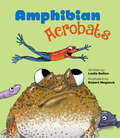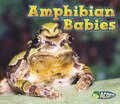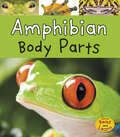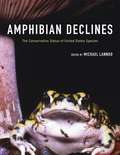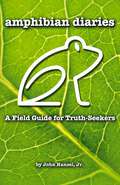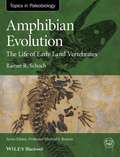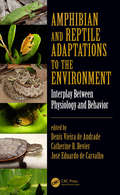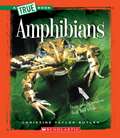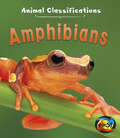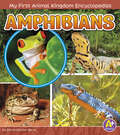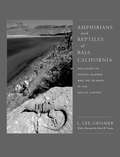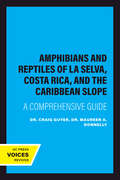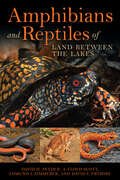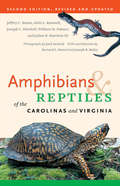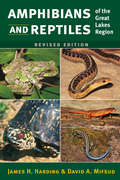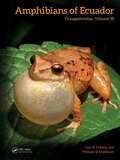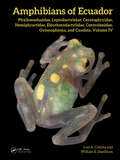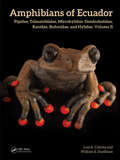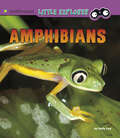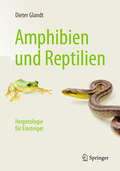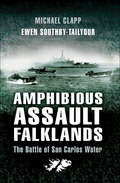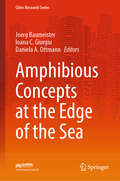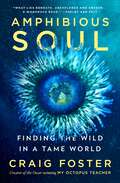- Table View
- List View
Amphetamines and Related Stimulants: Chemical, Biological, Clinical, and Sociological Aspects (Routledge Revivals)
by John CaldwellFirst published in 1980: The current texts represent the state-of-the-art on the use and abuse of amphetamines and related stimulants, from chemical, pharmacological, clinical, and social aspects.
Amphibian Acrobats
by Leslie BulionLeslie Bulion and Robert Meganck are back with another cross-curricular celebration of science and poetry—this time starring frogs, toads, salamanders, and more. Step right up and learn all about the remarkable stars of Leslie Bulion's Amphibian Acrobats show! Marvel at the jaw-dropping dexterity of "Daredevil Free-Climbers," the astounding agility of "The Olympic Jumpers," the awe-inspiring stamina of the intrepid "Marathoners," and more! Leslie Bulion's lively poems pair with Robert Meganck's colorful, zany art in this cross-curricular celebration of science and language. Thorough back matter includes a science glossary, notes on poetry forms, and resources for additional information about these extraordinary animals.
Amphibian Babies (Animal Babies Ser.)
by Catherine VeitchThis book looks at amphibian babies, and examines how amphibian babies are born, how they are cared for, how they develop, and differences and similarities between baby amphibians and their parents. The book also includes a picture glossary of key and difficult terms, and a page showing the life cycle of an amphibian.
Amphibian Body Parts (Animal Body Parts Ser.)
by Clare LewisFollow us on a journey around all the body parts of amphibians, from eyes to pouches, to feet to tails. Find out all about how each body part works, what it looks like, what it does, and how each body part differs between species.
Amphibian Declines: The Conservation Status of United States Species
by Michael J. LannooThe recent, sudden and dramatic decline in the abundance of amphibians is a world-wide environmental crisis. The cause of this decline is not known but many possibilities are reviewed in this mammoth 1000 page tome. This book describes in exhaustive and comprehensive detail the demise of amphibians throughout the world.
Amphibian Diaries: A Field Guide for Truth-Seekers
by John Hansel Jr.Amphibian Diaries is a Field Guide for Truth Seekers. A little, green stowaway in the author’s baggage turned out to be a good friend with a sage-like understanding of life. He taught six principles for recognizing Truth so people can have genuine, interpersonal dialogue while searching for personal significance. <P><P>By the time a reader is finished with the book, they’re invited into a safe and healthy conversation of life’s big questions with a friend. The invitation comes in the form of the LifeBet, reminiscent of the philosophy of Blasé Pascal, which states that all of us live our lives by a wager or bet we have made—there is a God, or there is no God. (The books main character, BP is named for Blasé Pascal.) <P><P>The book intends to launch LifeBet makers and takers into a commitment of seven meetings wherein they discus foundational life-issues: Origin, Meaning, Morality, and Destiny. Ultimately, the answers are a matter of faith for everyone—the primary constructs of our respective worldviews. <P><P>BP and the author would argue that these high-level meetings/conversations are essential but difficult, made practicable and effective by a commitment to SEARCH, an acronym for the six principles: <P><P>1) We all have a Soul with a hole, a need to be fulfilled by a significant and secure life. <P><P>2) We have an intrinsic Expectation of satisfaction that we cling to by faith. <P><P>3) We express our beliefs in terms of Answers to life’s ultimate and necessary questions: Origin, Meaning, Destiny, and Morality. <P><P>4) Our Reason to believe is always a matter of logical, empirical, and practical variables. <P><P>5) Our beliefs are an expression of our view of the Correspondence between our ideas about reality and reality itself. <P><P>And, 6) Intrapersonal, interpersonal, and inspirational Humility is required for the entire conversation Life and God. <P><P>The meetings and the ensuing dialogue are encouraged and assisted by the readers’ personal access to a designated website: www.AmphibianDiaries.com where they will find concise and insightful support materials as well as connection for interaction with the author and others. The book, the website, and the concept are all designed to move the reader in the direction of hope in a gentle and respectful manner. It presumes that if people genuinely seek Truth they will find themselves in the freedom of God’s love.
Amphibian Evolution
by Rainer R. SchochThis book focuses on the first vertebrates to conquer land and their long journey to become fully independent from the water. It traces the origin of tetrapod features and tries to explain how and why they transformed into organs that permit life on land. Although the major frame of the topic lies in the past 370 million years and necessarily deals with many fossils, it is far from restricted to paleontology. The aim is to achieve a comprehensive picture of amphibian evolution. It focuses on major questions in current paleobiology: how diverse were the early tetrapods? In which environments did they live, and how did they come to be preserved? What do we know about the soft body of extinct amphibians, and what does that tell us about the evolution of crucial organs during the transition to land? How did early amphibians develop and grow, and which were the major factors of their evolution?The Topics in Paleobiology Series is published in collaboration with the Palaeontological Association, and is edited by Professor Mike Benton, University of Bristol.Books in the series provide a summary of the current state of knowledge, a trusted route into the primary literature, and will act as pointers for future directions for research. As well as volumes on individual groups, the series will also deal with topics that have a cross-cutting relevance, such as the evolution of significant ecosystems, particular key times and events in the history of life, climate change, and the application of a new techniques such as molecular palaeontology.The books are written by leading international experts and will be pitched at a level suitable for advanced undergraduates, postgraduates, and researchers in both the paleontological and biological sciences.
Amphibian and Reptile Adaptations to the Environment: Interplay Between Physiology and Behavior
by Denis Vieira de Andrade Catherine R. Bevier José Eduardo de CarvalhoDespite their diversity, amphibians and reptiles share many physiological traits, such as their dependence on external heat sources for body temperature regulation, that are of pivotal importance to their ability to cope with the environment. Considerable variation in physiological capabilities exists in these groups and often can be related to seasonal and geographic differences in environmental parameters. This book provides a comprehensive and integrative view of the interplay between physiology and behavior in amphibians and reptiles, leading to a better understanding of the subject. The book covers topics that have recently been in the spotlight for scientific research on the physiology, behavior, and conservation of amphibians and reptiles. It brings together recent information from a range of disciplines that address critical topics for understanding their biology. As these studies are scattered across articles in specialized journals, this book provides a single and expanded source summarizing such advancements. Amphibian and Reptile Adaptations to the Environment: Interplay Between Physiology and Behavior maintains a solid scientific basis for the biological topics covered. However, it presents the material in a clear and direct manner so that it is accessible even to non-biologists interested in the basic biology, behavior, and ecology of these animals as well as how these elements are connected to their conservation.
Amphibians (A True Book: Animal Kingdom)
by Christine Taylor-ButlerA True Book: Animal Kingdom series introduces young investigative readers to animal species, their habitats, unique abilities as well as an up-close look at the dangers these animals face today and find out how humans can help keep all animal species from disappearing forever. This series includes an age appropriate (grades 3-5) introduction to curriculum-relevant subjects and a robust resource section that encourages independent study. Readers will discover how these incredible animals live double lives, spending time both on land and underwater. They will also find out how amphibians search for food and reproduce, as well as what dangers are facing these species today.
Amphibians (Animal Classifications Ser.)
by Angela RoystonThis book is all about amphibians: what they do, how they behave, and how these characteristics are different from other groups of animals. Beautifully illustrated with colorful photographs, the book shows many examples of different types of amphibians in their natural environment.
Amphibians (My First Animal Kingdom Encyclopedias Ser.)
by Emma Carlson BerneShine the science spotlight on frogs, toads, newts, salamanders, and caecilians! Organized by reference topics such as habitat, anatomy, and diet, Amphibians introduces young readers and browsers to these water-dependent animals through vibrant full-color photos and concise, factual text.
Amphibians and Reptiles of Baja California, Including Its Pacific Islands and the Islands in the Sea of Cortés
by L. Lee GrismerThis is a comprehensive review of what is known about all of the species of amphibians and reptiles in Baja California.
Amphibians and Reptiles of La Selva, Costa Rica, and the Caribbean Slope: A Comprehensive Guide
by Dr. Craig Guyer Dr. Maureen A. DonnellyThis field guide at last provides an authoritative and handy source for identifying amphibians and reptiles of Costa Rica's renowned Atlantic lowland tropical forests. Colorful frogs, lizards that can run across water, snapping turtles, spotted geckos, boa constrictors, crocodiles, and many other fascinating yet secretive species of amphibians and reptiles flourish in the region's myriad microhabitats. The La Selva Biological Station, a protected reserve, boasts a rich biota, making it and the surrounding area one of the most visited tropical forest sites in the world. For travelers, ecotourists, and biologists, this comprehensive guide, written by two distinguished experts on the area's amphibians and reptiles, will be an essential resource while visiting La Selva and the surrounding tropical forests of Costa Rica. In addition to providing reliable field identification, it will help visitors to this area better understand the overall role of Central American amphibians and reptiles in the natural world as well as conservation efforts now being undertaken to ensure the survival of these intriguing creatures.* 138 frogs, lizards, snakes, and crocodiles are included in keys based primarily on color patterns for easy identification * Each species is illustrated with a color photograph; the guide also features range maps and black-and-white drawings * Includes an overview of the natural history of each amphibian and reptile and gives helpful tips on where to observe them
Amphibians and Reptiles of Land Between the Lakes
by David H. Snyder A. Floyd Scott Edmund J. Zimmerer David F. FrymireKnown for its natural beauty, Land Between the Lakes National Recreation Area is the largest inland peninsula in the United States. Consisting of 170,000 acres of forested and protected public land between Kentucky Lake (Tennessee River) and Lake Barkley
Amphibians and Reptiles of the Carolinas and Virginia
by William M. Palmer Jack Dermid Julian R. Harrison Alvin L. Braswell Jeffrey C. BeaneRevised and updated to reflect the most current science, and including 30 new species, this authoritative and comprehensive volume is the definitive guide to the amphibians and reptiles of the Carolinas and Virginia. The new edition features 189 species of salamanders, frogs, crocodilians, turtles, lizards, and snakes, with updated color photographs, descriptions, and distribution maps for each species. It is an indispensable guide for zoologists, amateur naturalists, environmentalists, backpackers, campers, hikers, and everyone interested in the outdoors.
Amphibians and Reptiles of the Great Lakes Region, Revised Ed.
by David A Mifsud James H. HardingThe revised edition of this well-loved guide is the essential reference for the identification of amphibians and reptiles in the Great Lakes region. Fully updated treatments of over 70 species feature detailed information on the distribution, habitat, behavior, and life history of these fascinating animals. This edition includes all new distribution maps as well as 90 additional color photographs showing close-ups of distinguishing features, common color phases, and different metamorphic stages. A thorough introduction provides a wealth of information on the evolution, natural history, classification, and conservation of these animals and examines changing Great Lakes ecosystems and their impact on herpetological diversity. Amphibians and Reptiles of the Great Lakes Region is a must-have resource for teachers, students, naturalists, professional biologists, and anyone else with an interest in this region’s ecology.
Amphibians of Ecuador: Craugastoridae
by William E. Duellman Luis A. ColomaAmphibians of Ecuador: Craugastoridae. Volume III is the third in a four-volume series that provides comprehensive, well-illustrated, and authoritative insights, making it an invaluable resource for biologists, conservationists, and others. The series explores, in comprehensive detail, the cultural history and the rich amphibian diversity of Ecuador, providing a thorough review of biogeography, amphibian declines, and conservation.Volume III specifically focuses on Craugastoridae. Characteristics of each species are listed, defined, and compared to other similar species. Reproductive behavior, where known, is described, as are data on vocalizations. Amphibian distributions are detailed and illustrated with physiographic maps with dots. The volume also addresses the declines, extinctions, and conservation status of each species, noting their occurrence in reserves.KEY FEATURES: Provides detailed and comprehensive accounts for all Craugastoridae species from Ecuador New data are incorporated for many species Describes with full color maps the distribution of all known taxa Includes information on the ecology, reproduction, and behavior of all taxa
Amphibians of Ecuador: Phyllomedusidae, Leptodactylidae, Ceratophryidae, Hemiphractidae, Eleutherodactylidae, Centrolenidae, Gymnophiona and Caudata, Volume IV
by William E. Duellman Luis A. ColomaAmphibians of Ecuador, Volume IV is the final installment in a four-volume series that provides comprehensive, well-illustrated, and authoritative insights into the amphibian species of Ecuador, making it an invaluable resource for biologists, conservationists, and others. The series explores, in comprehensive detail, the cultural history and the rich amphibian diversity of Ecuador, providing a thorough review of biogeography, amphibian declines, and conservation.Volume IV specifically focuses in Phyllomedusidae, Leptodactylidae, Ceratophryidae, Hemiphractidae, Eleutherodactylidae, Centrolenidae, Gymnophiona, and Caudata. Characteristics of each species are listed, defined, and compared to similar other species. Reproductive behavior, where known, is described as are data on vocalizations, larvae and ontogenetic changes. Amphibian distributions are detailed and illustrated with physiographic maps with dots. The volume also addresses the declines, extinctions, and conservation status of each species, highlighting their occurrence in protected areas.Key Features: Provides detailed and comprehensive accounts for all species from Ecuador of Phyllomedusidae, Leptodactylidae, Ceratophryidae, Hemiphractidae, Eleutherodactylidae, Centrolenidae, Gymnophiona, and Caudata. An Addendum includes accounts of species described from 2023 to 2024. New data are incorporated for many species. Describes with full color maps the distribution of all known taxa. Includes information on the ecology, reproduction, and behavior of all taxa.
Amphibians of Ecuador: Pipidae, Telmatobiidae, Microhylidae, Dendrobatidae, Ranidae, Bufonidae, and Hylidae, Volume II
by Luis A. Coloma William E. DuellmanThis book is the second of four volumes, which are comprehensive, well-illustrated, and authoritative works invaluable to biologists, conservationists, and others. It explores, in comprehensive detail, the rich amphibian diversity of Ecuador, providing a thorough review of biogeography, amphibian declines, and conservation. This volume covers Pipidae, Telmatobiidae, Microhylidae, Dendrobatidae, Ranidae, Bufonidae, and Hylidae. Characteristics of each species are listed, defined, and compared to similar other species. Reproductive behavior, where known, is described, as are data on vocalizations, larvae, and ontogenetic changes. Amphibian distributions are illustrated with physiographic maps with dots. Each volume addresses the declines, extinctions, and conservation status of each species and provides notations of their occurrence in reserves.KEY FEATURES Provides detailed and authoritative accounts for each species in seven families: Pipidae, Telmatobiidae, Microhylidae, Dendrobatidae, Ranidae, Bufonidae, and Hylidae New data are incorporated for many species Describes with full-color maps the distribution of all known taxa Includes information on the ecology, reproduction, and behavior of all taxa
Amphibians: A 4d Book (Little Zoologist Ser.)
by Sally LeeDid you know that the Fowler's toad can lay 20,000 eggs? Meet friendly frogs, giant salamanders, and other amazing amphibians at the Smithsonian National Zoo in these first books reviewed by Smithsonian experts. Bring augmented reality to your students by downloading the free Capstone 4D app and scanning for access to awesome videos!
Amphibien und Reptilien: Herpetologie für Einsteiger
by Dieter GlandtAls #65533;beraus erfahrener Herpetologe, dessen Wissen und Erfahrung in zahlreiche Fachb#65533;cher Eingang gefunden hat, ist Dieter Glandt pr#65533;destiniert, dieses fachlich fundierte und gleichzeitig gut verst#65533;ndliche Buch zu den Lurchen und Kriechtieren zu verfassen. Brillante Fotos renommierter Fotografen sowie didaktisch ansprechende Grafiken runden das Buch ab und erlauben ein Schm#65533;kern in diesem f#65533;r den Wissenschaftler anregenden wie auch Laien verst#65533;ndlichen Werk. Wie lassen sich die Tiere am besten beobachten und bestimmen? Der Autor erl#65533;utert einige wichtige Methoden, etwa die immer h#65533;ufiger genutzten Wasserfallen. Wenn Sie wissen wollen, f#65533;r welchen Zweck sich welche Methode am besten eignet, dann finden Sie hier wertvolle Entscheidungshilfen. Viele Lurche und Kriechtiere sind stark gef#65533;hrdet oder vom Aussterben bedroht. Warum dies so ist und was sich dagegen tun l#65533;sst, ist ein Schwerpunkt dieses Buches. Auch auf der Suche nach Tipps f#65533;r die Neuanlage von Kleingew#65533;ssern und die Pflege #65533;lterer Lebensr#65533;ume sowie Hinweise f#65533;r den Schutz der hochgradig bedrohten Meeresschildkr#65533;ten finden sich in dieser Einf#65533;hrung.
Amphibious Assault Falklands: The Battle of San Carlos Water
by Ewen Southby-Tailyour Michael ClappA British Naval commander&’s eyewitness account of the 1982 war in the South Atlantic. Since he was in charge of the amphibious operations in the Falklands War, it goes without saying that there is no one better qualified to tell the story of that aspect of the campaign than Commodore Michael Clapp. Here he describes, with considerable candor, some of the problems met in a Navy racing to war and finding it necessary to recreate a largely abandoned operational technique in a somewhat ad hoc fashion. During the time it took to &“go south,&” some sense of order was imposed and a not very well defined command structure evolved, this was not done without generating a certain amount of friction. He tells of why San Carlos Water was chosen for the assault and the subsequent inshore operations. Michael Clapp and his small staff made their stand and can claim a major role in the defeat of the Argentine Air and Land Forces.
Amphibious Concepts at the Edge of the Sea (Cities Research Series)
by Joerg Baumeister Daniela A. Ottmann Ioana C. GiurgiuThis book explores interfaces between land and sea and their geostrategic, ecological, urban, productive, indigenous, legal, historical, and artistic dimensions. The oceans, comprising two-thirds of the earth's surface, were initially utilised mainly for transportation and fishing. Today they serve diverse purposes such as supplying energy, freshwater, mineral resources, supporting leisure activities, and providing habitat. Additionally, the UN set up the first international agreement establishing Marine Protection Areas for a third of the sea to mitigate the growing use and exploitation. The more interest in oceans' territories increases, the more the question arises about the beneficial evolution of their physical and legal boundaries. What innovative amphibious concepts can be developed for the edge of the sea? The book pushes the boundaries of current knowledge to provide a deeper insight into the upcoming challenges and opportunities, makingit easier to apply the best strategies for a healthy future for both the ocean and humanity.
Amphibious Soul: Finding the Wild in a Tame World
by Craig Foster“An important book that will transform how we think about being human. … that will inspire hope.”—Jane GoodallHow can we reclaim the soul-deepening wildness that grounds us and energizes us when so much of the modern world seems designed to tame us?In this thrilling memoir of a life spent exploring the most incredible places on Earth—from the Great African Seaforest to the crocodile lairs of the Okavango Delta—Craig Foster reveals how we can attend to the earthly beauty around us and deepen our love for all living things, whether we make our homes in the country, the city, or anywhere in between.Foster explores his struggles to remain present to life when a disconnection from nature and the demands of his professional life begin to deaden his senses. And his own reliance on nature’s rejuvenating spiritual power is put to the test when catastrophe strikes close to home.Foster’s lyrical, riveting Amphibious Soul draws on his decades of daily ocean dives, wisdom from Indigenous teachers, and leading-edge science.
Amphibious Subjects: Sasso and the Contested Politics of Queer Self-Making in Neoliberal Ghana (New Sexual Worlds #2)
by Kwame Edwin OtuA free open access ebook is available upon publication. Learn more at www.luminosoa.org.Amphibious Subjects is an ethnographic study of a community of self-identified effeminate men—known in local parlance as sasso—residing in coastal Jamestown, a suburb of Accra, Ghana's capital. Drawing on the Ghanaian philosopher Kwame Gyekye's notion of "amphibious personhood," Kwame Edwin Otu argues that sasso embody and articulate amphibious subjectivity in their self-making, creating an identity that moves beyond the homogenizing impulses of western categories of gender and sexuality. Such subjectivity simultaneously unsettles claims purported by the Christian heteronationalist state and LGBT+ human rights organizations that Ghana is predominantly heterosexual or homophobic. Weaving together personal interactions with sasso, participant observation, autoethnography, archival sources, essays from African and African-diasporic literature, and critical analyses of documentaries such as the BBC's The World’s Worst Place to Be Gay, Amphibious Subjects is an ethnographic meditation on how Africa is configured as the "heart of homophobic darkness" in transnational LGBT+ human rights imaginaries.

